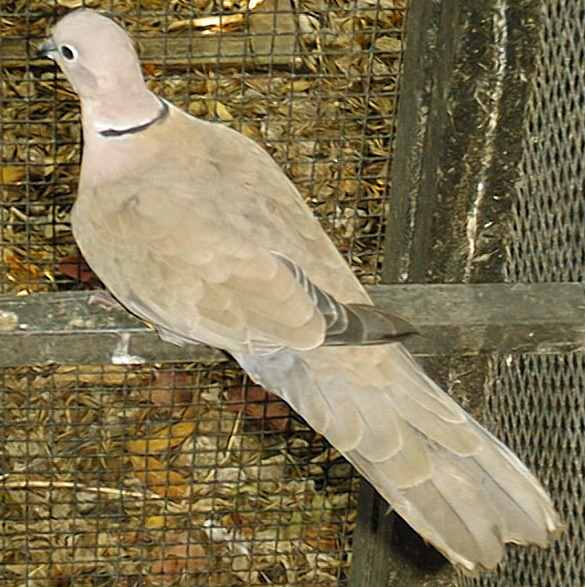
ŠJohn Pire
Eurasian Collared Dove
Streptopelia decaocto
AKA: Indian Ringdove, Collared Dove, Collared Turtle Dove, Eastern Ringdove, Eurasian Ringdove

ŠJohn Pire

Bird photographed in it's native range - India


ŠJohn Pire
Sinai, Egypt
Tail Spikes - underside of tail

ŠJohn Pire
Distribution: In it's original "India" range it is found in many dry open areas with scrub; associates with man altered habitats such as agricultural land which still has trees & scrub, takes advantage of many suburban gardens & parks. This species has expanded it's range to include much of Europe, including England; the Middle East, south west to Palestine, coastal regions of the Oman peninsula; Chinese Turkestan, northern, central & western China, Korea & a small area of Japan. Well documented in it's European expansion & in the 1970's it's introduction to the Bahama Islands & future expansion to other Caribbean Islands & now it's rapid United States expansion.
Two races recognized: S. d. decaocto (Frivaldszky 1838); S. d. xanthocylus (Newman 1906) - has a yellow eye cere instead of the whitish grey eye cere color of the nominate race.
Description: Length 32 cm. Forehead soft grey, crown to nape greyish brown suffused with pinkish or vinous. A white edged black "half" collar on hindneck. Mantle, back to uppertail coverts a grey brown. Wing shield edge a grey blue edging. Primary flights almost black with narrow pale edging. Central tail feathers grey brown. Outer tail feathers grey with white tips. Chin & throat whitish, sides of neck to belly dull pinkish grey merging into dark grey undertail coverts & vent region. The outer tail feather on each side has a unique "spike" on the outer edge (see picture above). This "spike" is not found in any other "ring-necked" species. Eye dark red-brown. Females are duller overall. Juveniles dull versions of the adults with slight buff feather edging; no black neck ring.
Voice: ![]() Females also utter the advertising, display & excitement
call with as much intensity as the males.
Females also utter the advertising, display & excitement
call with as much intensity as the males.
![]() Excitement Cry
Excitement Cry
Nesting: Clutch two white eggs; incubation 14 days; juveniles fledge in about two weeks & are independent in another week. In warmer areas of it's native & introduced ranges this species can raise from 3-6 clutches of young.
NOTE: Originally a Mid-Eastern species, the Eurasian Collared-Dove has extended its range dramatically into western Europe since about 1930. It was inadvertently released in the Bahamas in the 1970s then spread to South Florida, probably by natural means, in the late 1970s or early 1980s. Florida birds were initially mistaken for feral populations of Ringneck Dove (Streptopelia risora), a domestic cage bird with no natural populations anywhere in the world. This mistake was soon corrected, and the species was officially recognized in the U.S. in the 1990s. It is expanding its presence rapidly north and west. It has been documented in many States already (2003).